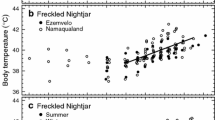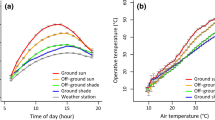Abstract
Compared to mammals, there are relatively few studies examining heterothermy in birds. In 13 bird families known to contain heterothermic species, the common poorwill (Phalaenoptilus nuttallii) is the only species that ostensibly hibernates. We used temperature-sensitive radio-transmitters to collect roost and skin temperature (Tskin) data, and winter roost preferences for free-ranging poorwills in southern Arizona. Further, to determine the effect of passive rewarming on torpor bout duration and active rewarming (i.e., the use of metabolic heat to increase Tskin), we experimentally shaded seven birds during winter to prevent them from passively rewarming via solar radiation. Poorwills selected winter roosts that were open to the south or southwest, facilitating passive solar warming in the late afternoon. Shaded birds actively rewarmed following at least 3 days of continuous torpor. Average torpor bout duration by shaded birds was 122 h and ranged from 91 to 164 h. Active rewarming by shaded birds occurred on significantly warmer days than those when poorwills remained torpid. One shaded bird remained inactive for 45 days, during which it spontaneously rewarmed actively on eight occasions. Our findings show that during winter poorwills exhibit physiological patterns and active rewarming similar to hibernating mammals.



Similar content being viewed by others
References
Austin GT, Bradley WG (1969) Additional responses of the Poor-will to low temperatures. Auk 86:717–725. https://doi.org/10.2307/4083459
Barclay RMR, Lausen CL, Hollis L (2001) What’s hot and what’s not: defining torpor in free-ranging birds and mammals. Can J Zool 79:1885–1890. https://doi.org/10.1139/cjz-79-10-1885
Bartholomew GA, Hudson JW, Howell TR (1962) Body temperature, oxygen consumption, evaporative water loss, and heart rate in the poor-will. Condor 2:117–125. https://doi.org/10.2307/1365480
Bicudo JEPW, Vianna CR, Chaui-Berlinck JG (2001) Thermogenesis in birds. Biosci Rep 21:181–188. https://doi.org/10.1023/A:1013648208428
Bicudo JEPW, Bianco AC, Vianna CR (2002) Adaptive thermogenesis in hummingbirds. J Exp Biol 205:2267–2273
Brigham RM (1992) Daily torpor in a free-ranging goatsucker, the common poorwill (Phalaenoptilus nuttallii). Physiol Zool 65:457–472. https://doi.org/10.2307/30158263
Brigham RM, Trayhurn P (1994) Brown fat in birds? A test for the mammalian BAT-specific mitochnodrial uncoupling protein in common poorwills. Condor 96:208–211. https://doi.org/10.2307/1369080
Brigham RM, Gutsell RCA, Wiacek RS, Geiser F (1999) Foraging behaviour in relation to the lunar cycle by Australian owlet-nightjars Aegotheles cristatus. Emu 99:253–261. https://doi.org/10.1071/MU99031
Brigham RM, Willis CKR, Geiser F, Mzilikazi N (2011) Baby in the bathwater: should we abandon the use of body temperature thresholds to quantify expression of torpor? J Therm Biol 36:376–379. https://doi.org/10.1016/j.jtherbio.2011.08.001
Buck CL, Barnes BM (1999) Temperatures of hibernacula and changes in body composition of arctic ground squirrels over winter. J Mammal 80:1264–1276. https://doi.org/10.2307/1383177
Chruszcz BJ, Barclay RMR (2002) Thermoregulatory ecology of a solitary bat, Myotis evotis, roosting in rock crevices. Funct Ecol 16:18–26. https://doi.org/10.1046/j.0269-8463.2001.00602.x
Currie SE, Noy K, Geiser F (2015) Passive rewarming from torpor in hibernating bats: minimizing metabolic costs and cardiac demands. Am J Physiol Regul Integr Comp Physiol 308:R34–R41. https://doi.org/10.1152/ajpregu.00341.2014
Czenze ZJ, Brigham RM, Hickey AJR, Parsons S (2017) Winter climate affects torpor patterns and roost choice in New Zealand lesser short-tailed bats. J Zool 303:236–243. https://doi.org/10.1111/jzo.12486
Dausmann KH, Glos J, Ganzhorn JU, Heldmaier G (2004) Hibernation in a tropical primate. Nature 429:825–826. https://doi.org/10.1038/429825a
Dawson WR, Fisher CD (1969) Responses to temperature by the spotted nightjar (Eurostopodus guttatus). Condor 71:49–53. https://doi.org/10.2307/1366047
Dawson WR, Whittow GC (2000) Regulation of body temperature. In: Whittow GC (ed) Avian physiology, 5th edn. Academic Press, San Diego, pp 343–390
French AR (1985) Allometries of the durations of torpid and euthermic intervals during mammalian hibernation: a test of the theory of metabolic control of the timing of changes in body temperature. J Comp Physiol B 156:13–19. https://doi.org/10.1007/BF00692921
French AR (1993) Hibernation in birds: comparison with mammals. In: Carey C, Florant GL, Wunder BA, Horowitz B (eds) Life in the cold: ecological, physiological, and molecular mechanisms. Westview Press, Boulder, pp 43–53
Geiser F (2004) Metabolic rate and body temperature reduction during hibernation and daily torpor. Annu Rev Physiol 66:239–274. https://doi.org/10.1146/annurev.physiol.66.032102.115105
Geiser F, Broome LS (1991) Hibernation in the mountain pygmy possum Burramys parvus (Marsupialia). J Zool 223:593–602. https://doi.org/10.1111/j.1469-7998.1991.tb04390.x
Geiser F, Drury RL (2003) Radiant heat affects thermoregulation and energy expenditure during rewarming from torpor. J Comp Physiol B 173:55–60. https://doi.org/10.1007/s00360-002-0311-y
Geiser F, Ruf T (1995) Hibernation versus daily torpor in mammals and birds: physiological variables and classification of torpor patterns. Physiol Zool 68:935–966. https://doi.org/10.1086/physzool.68.6.30163788
Geiser F, Hiebert S, Kenagy GJ (1990) torpor bout duration during the hibernation season of two sciurid rodents: interrelations with metabolism and temperature. Physiol Zool 63:489–503. https://doi.org/10.2307/30156224
Geiser F, Drury RL, Kortner G, Turbill C, Pavey CR, Brigham RM (2004) Passive rewarming from torpor in mammals and birds: energetic, ecological and evolutionary implications. In: Barnes BM, Carey HV (eds) Life in the cold: evolution, mechanisms, adaptations and applications, vol 27, 12th edn. University of Alaska, Fairbanks, pp 51–61
Howell TR, Bartholomew GA (1959) Further experiments on torpidity in the poor-will. Condor 61:180–185. https://doi.org/10.2307/1365534
Jaeger EC (1948) Does the poorwill “hibernate”. Condor 50:45–46
Jaeger EC (1949) Further observations on the hibernation of the poor-will. Condor 51:105–109. https://doi.org/10.2307/1365104
Lane JE, Swanson DL, Brigham RM, McKechnie AE (2004) Physiological responses to temperature by whip-poor-wills: more evidence for the evolution of low metabolic rates in Caprimulgiformes. Condor 106:921–925. https://doi.org/10.1650/7521
Lasiewski RC (1969) Physiological responses to heat stress in the poorwill. Am J Physiol 217:1504–1509
Lasiewski RC, Dawson WR (1964) Physiological responses to temperature in the common nighthawk. Condor 66:477–490. https://doi.org/10.2307/1365224
Lasiewski RC, Dawson W, Bartholomew G (1970) Temperature regulation in the little Papuan frogmouth, Podargus ocellatus. Condor 72:332–338. https://doi.org/10.2307/1366012
Ligon JD (1970) Still more responses of the poor-will to low temperatures. Condor 72:496–498. https://doi.org/10.2307/1366415
Lyman CP (1982) Who is who among the hibernators. In: Lyman CP, Willis JS, Malan A, Wang LCH (eds) Hibernation and torpor in mammals and birds. Academic Press, New York, pp 12–36
Malan A, Ciocca D, Challet E, Pévet P (2018) Implicating a temperature-dependent clock in the regulation of torpor bout duration in classic hibernation. J Biol Rhythms. https://doi.org/10.1177/0748730418797820
McKechnie AE, Lovegrove BG (2002) Avian facultative hypothermic responses: a review. Condor 104:705–724. https://doi.org/10.1650/0010-5422(2002)104%5b0705:AFHRAR%5d2.0.CO;2
McNab BK, Bonaccorso FJ (1995) The energetics of Australasian swifts, frogmouths, and nightjars. Physiol Zool 68:245–261. https://doi.org/10.2307/30166502
Michener GR (1992) Sexual differences in over-winter torpor patterns of Richardson’s ground squirrels in natural hibernacula. Oecologia 89:397–406. https://doi.org/10.1007/BF00317418
Mzilikazi N, Lovegrove BG, Ribble DO (2002) Exogenous passive heating during torpor arousal in free-ranging rock elephant shrews, Elephantulus myurus. Oecologia 133:307–314. https://doi.org/10.1007/s00442-002-1052-z
O’Connor RS, Brigham RM, McKechnie AE (2018) Extreme operative temperatures in exposed microsites used by roosting rufous-cheeked nightjar (Caprimulgus rufigena): implications for water balance under current and future climate conditions. Can J Zool 96:1122–1129. https://doi.org/10.1139/cjz-2017-0310
Racey PA, Swift SM (1985) Feeding ecology of Pipistrellus pipistrellus (Chiroptera: Vespertilionidae) during pregnancy and lactation. I. Foraging behaviour. J Anim Ecol 54:205–215
Rintoul JLP, Brigham RM (2014) The influence of reproductive condition and concurrent environmental factors on torpor and foraging patterns in female big brown bats (Eptesicus fuscus). J Comp Physiol B Biochem Syst Environ Physiol 184:777–787. https://doi.org/10.1007/s00360-014-0837-9
Ruf T, Geiser F (2015) Daily torpor and hibernation in birds and mammals. Biol Rev 90:891–926. https://doi.org/10.1111/brv.12137
Rydell J, Entwistle A, Racey PA (1996) Timing of foraging flights of three species of bats in relation to insect activity and predation risk. Oikos 76:243. https://doi.org/10.2307/3546196
Solick DI, Barclay RMR (2006) Thermoregulation and roosting behaviour of reproductive and nonreproductive female western long-eared bats (Myotis evotis) in the Rocky Mountains of Alberta. Can J Zool 84:589–599. https://doi.org/10.1139/z06-028
Stebbins RC (1957) A further observation on torpidity in the poor-will. Condor 59:2307
Strijkstra AM, Daan S (1997) Sleep during arousal episodes as a function of prior torpor duration in hibernating European ground squirrels. J Sleep Res 6:36–43. https://doi.org/10.1046/j.1365-2869.1997.00024.x
Tannenbaum MG, Pivorun EB (1984) Differences in daily torpor patterns among three southeastern species of Peromyscus. J Comp Physiol B 154:233–236. https://doi.org/10.1007/BF02464401
Thomas DW, Dorais M, Bergeron J-M (1990) Winter energy budgets and cost of arousals for hibernating little brown bats, Myotis lucifugus. J Mammal 71:475–479. https://doi.org/10.2307/1381967
Thompson ML, Mzilikazi N, Bennett NC, McKechnie AE (2015) Solar radiation during rewarming from torpor in elephant shrews: supplementation or substitution of endogenous heat production? PLoS One 10:1–15. https://doi.org/10.1371/journal.pone.0120442
Thorburg F (1953) Another hibernating poor-will. Condor 55:2307
Walsberg GE, Weathers WW (1986) A simple technique for estimating operative environmental temperature. J Therm Biol 11:67–72. https://doi.org/10.1016/0306-4565(86)90020-3
Wang LCH (1979) Time patterns and metabolic rates of natural torpor in the Richardson’s ground squirrel. Can J Zool 57:149–155. https://doi.org/10.1139/z79-012
Wang LCH (1989) Ecological, physiological, and biochemical aspects of torpor in mammals and birds. In: Wang LCH (ed) Advances in comparative and environmental physiology. Animal adaptation to cold. Springer, Berlin Heidelberg, pp 361–401
Warnecke L, Turner JM, Geiser F (2008) Torpor and basking in a small arid zone marsupial. Naturwissenschaften 95:73–78. https://doi.org/10.1007/s00114-007-0293-4
Withers PC (1977) Respiration, metabolism, and heat exchange of euthermic and torpid poorwills and hummingbirds. Physiol Zool 50:43–52. https://doi.org/10.1086/physzool.50.1.30155714
Wolf BO, Walsberg GE (1996) Thermal effects of radiation and wind on a small bird and implications for microsite selection. Ecology 77:2228–2236. https://doi.org/10.2307/2265716
Wolf BO, Wooden KM, Walsberg GE (1996) The use of thermal refugia by two small desert birds. Condor 98:424–428. https://doi.org/10.2307/1369162
Woods CP (2002) Ecological aspects of torpor use and inactivity during winter by common poorwills. PhD Dissertation, Univeristy of Regina, Saskatchewan, Canada
Woods CP, Brigham RM (2004) The avian enigma: “hibernation” by common poorwills (Phalaenoptilus nuttallii). In: Barnes BM, Carey HV (eds) Life in the cold: evolution, mechanisms, adaptations and applications, vol 27, 12th edn. University of Alaska, Fairbanks, pp 231–240
Acknowledgements
We gratefully acknowledge the field assistance of P. Bradshaw, G. Draheim, E. Geiger, J. and E. Penn, B. Sechler, and B. Woods. We thank B. Branan for his input and logistic support. We thank A. McKechnie, S. Parsons, B. Smit, B. Wolf, and two anonymous reviewers for comments on an earlier version of this manuscript that greatly improved its quality. We are grateful to the late D.W. Thomas for his input to C.P. Woods’ thesis and our thinking about these birds.
Funding
Funding for this research was provided in part by Faculty of Graduate Studies and Research at the University of Regina, the Peregrine Fund, Inc., and an NSERC Discovery grant to R.M.B.
Author information
Authors and Affiliations
Contributions
CPW and RMB conceived the ideas and designed methodology. CPW and RMB collected the data. CPW and RMB analysed the data. ZJC led the writing of the manuscript. All authors critically evaluated drafts and gave final approval for publication.
Corresponding author
Ethics declarations
Conflict of interest
The authors declare no competing or financial interests.
Additional information
Communicated by Blair Wolf.
Rights and permissions
About this article
Cite this article
Woods, C.P., Czenze, Z.J. & Brigham, R.M. The avian “hibernation” enigma: thermoregulatory patterns and roost choice of the common poorwill. Oecologia 189, 47–53 (2019). https://doi.org/10.1007/s00442-018-4306-0
Received:
Accepted:
Published:
Issue Date:
DOI: https://doi.org/10.1007/s00442-018-4306-0




